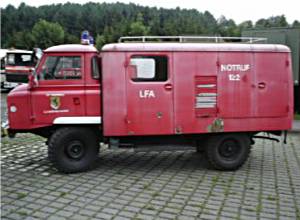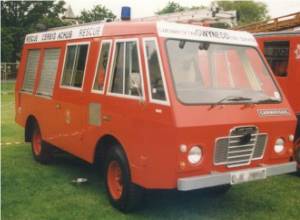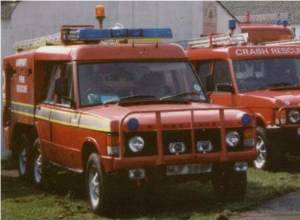Fire / Crash Tenders
Series I
 |
88" Series I |
Some vehicles were fitted with 40-gallon water tanks, and a pump powered via the PTO. More often vehicles were used in support roles for other vehicles, carrying supplies utilised as hose-carriers or serving as towing vehicles for trailer pumps. Pictured here you can see the bonnet of this 88" model been used to carry a hosepipe.
It was soon apparent that Rover did not understand the market and had not been prepared for the differing specifications that customers wanted. This lead to Carmichael's of Worcester been appointed in the mid 1950's as the approved vehicle converter because of their established expertise in the field of fire fighting. These and other companies were very successful and produced many versions of appliances.
Series II
 |
  |
Series II Firefly |
Pictured here is a 1960 series II 109" Firefly Fire Tender, the vehicle's bodywork was converted by George Angus & Co. Ltd (now Angus Fire).
It was supplied new to English Electric (which became part of British Aerospace), where it worked up until 1995 a tribute to the crew that maintained it
and to the endurance of the Landrover itself.
Fire services continued to use Landrover's as support vehicles to carry equipment or fire fighters as well as dedicated pump vehicles.
Series IIa/III
 |
TACR1 Series IIa/III |
Due to the way the MOD operates its contract system a number of contractors would produce a vehicle to the same specifications. This leads to differing appearances across a range of vehicles that should be the same; this is most notable with the TACR2.
The differences between a Series IIa and a Series III are the same as that in the civilian production vehicles. Carmichael's also produced a small number of Series III FC Fire tenders.
Forward Control Series IIa/IIb
 |
  |
The Configuration allowed coach builders to incorporate a rear bench seat to the cab to house a bigger crew. The wheelbase was increased to 110" in 1966 when the vehicle became designated Series IIb.
pictured left is a Series IIb vehicle as used by the Austrian Fire-Brigade it features a porch-pump and a cab with 9 seats.
Dennis Brothers Coach builders produced a prototype based on the 88" FC chassis, this was found to be an unstable platform due to pitching and only 2 were built.
Forward Control Series III
 |
SIII Carmichael |
F.I. Bates of Evesham also produced a Series III Forward Control vehicles known as FC108/Bates L4P Fire Engine between 1973 and 1978 most were supplied to the Northern Ireland Fire Brigade. These 4-seated vehicles were produced with a 100-gallon water tank which had to be replaced with 50-gallon tanks due to stability problems, around 53 were built.
Range Rover
 |
TACR2 Range Rover |
Unfortunately the additional axle was prone to "digging in" on soft ground reducing it's off road capabilities.
 |
Recovery |
A retired Station Officer told me that during this "green period" he had gone on leave, the tenders were the matt-green when he left. On his return he found to his surprised the vehicles were now a very shiny gloss-green; the sergeant informed him that the men had cleaned and polished the tenders for his return. This change restored some of the lost pride in the vehicles to the crews.
Following complaints from the Ministry of Transport that it was now very difficult to distinguish the Crash Tenders from normal military vehicles on public roads, the Tenders were returned to the original red colour.
TACR1's & TACR2's can be seen at the RAF Fire Service Museum, Half Penny Green, Wolverhampton.
90 & 110 / Defender
 |
90" & 110" Tenders |
The current production Fire Fighting model to come from the Special Vehicles Division of Landrover is based on either the Defender D110 or D130 with a choice of single or double crew cab and the Td5 engine fitted. Features include Collins Youldon hose reels and a 900-litre water tank.
Three fire-fighting options available are a soaker system, a compressed air foam (CAF) system or a fire fogging system.
The fire fogging system produces heat-absorbing vapour, which uses less water to greater effect than a conventional system.
John Dennis Coach builders (JDC) is also producing fire-fighting vehicles based on the Land Rover chassis.